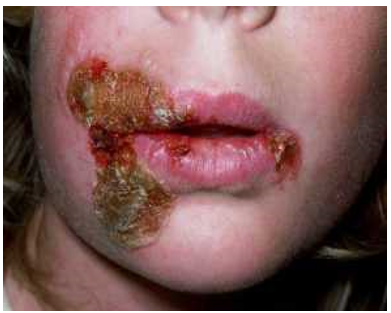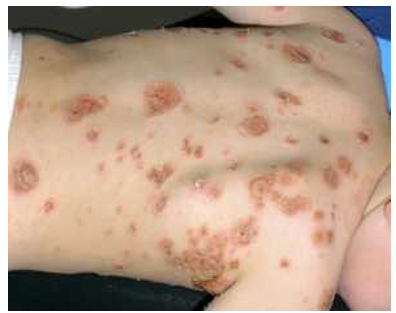Comments from Expert Advisory Group
- Impetigo in children is highly contagious
- Do not offer combination topical and oral antibiotics
- As resistance is increasing reserve topical antibiotics for very localised lesions (≤ 3 lesions). Prior to application of topical antibiotics soak off crusts with petroleum jelly (Vaseline®) and gently remove with a warm, damp facecloth to increase absorption
- HPSC update on group A Streptococcus
- Panton-Valentine Leukocidin (PVL) is a toxin produced by 2% of Staphylococcus aureus and is associated with persistent recurrent pustules and carbuncles or cellulitis. Send swabs for culture in these clinical scenarios. On rare occasions it causes more severe invasive infections, even in otherwise fit people. Risk factors include: nursing homes, contact sports, sharing equipment, poor hygiene and eczema
| Non-bullous vs Bullous Impetigo |
| Image: Non-Bullous Impetigo |
Image: Bullous Impetigo |
|

Perioral honey-coloured crusts in impetigo
Image Source: Dermnet
|

Widespread bullous impetigo over the back
Image Source: Dermnet
|
Treatment
| Flucloxacillin |
See flucloxacillin dosing table for children |
500mg every 6 hours |
5-7 days |
Avoid in penicillin allergy
To optimise absorption, take on an empty stomach (either 1 hour before food or 2 hours after food).
|
| 2nd choice options |
|
Cefalexin
|
See cefalexin dosing table for children |
500mg every 12 hours |
5-7 days |
Cephalosporins should not be used in severe penicillin allergy. |
|
Clarithromycin
|
See clarithromycin dosing table for children |
250mg every 12 hours
(can be increased if necessary in severe infection to 500mg every 12 hours) |
5-7 days |
Macrolides should be used with caution in pregnancy. Clarithromycin suitable only in 2nd and 3rd trimester in pregnancy. |
| 1st choice option in pregnant, penicillin allergic patients |
|
Clindamycin
|
|
300mg every 6 hours |
5-7 days |
Caution: risk of C. difficile. |
|
Topical Treatment for Non-Bullous Impetigo (Reserve for very localised lesions – ≤3 lesions)
|
|
Fusidic Acid
|
Topically to affected areas every 8 hours |
5-7 days |
|
Advice for the patient/carer
- Contact school/child care facilities to determine how long a child should stay away (usual guidance is to stay home until lesions have crusted over, or until 24 hours after patients have started treatment, however some establishments may have their own guidance)
- Keep sores, blisters and crusty patches clean and dry
- Encourage patient and household contacts to wash hands regularly
- Wash flannels, sheets and towels at a high temperature
- Wash or wipe down toys with detergent and warm water if children have impetigo
Patient Information
We recommend patients use the following links to get further information about managing impetigo:
Reviewed November 2022
